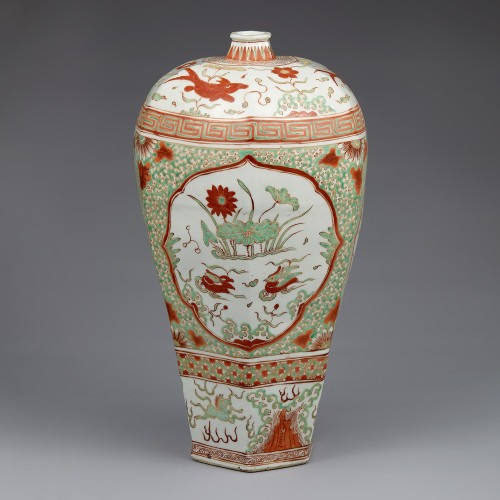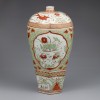본문
이 유물은 명대에 제작된 것으로 추정되는 홍녹채(紅綠彩) 기법의 육각매병(六角梅甁)입니다. 흰색 유약을 시유한 뒤 붉은색과 녹색 안료로 연지(蓮池), 원앙(鴛鴦), 해마(海馬), 어문(魚紋) 등 다양한 길상 문양을 화려하게 시문하였습니다. 부푼 어깨와 완만하게 좁아지는 저부, 육각형의 구연부와 굽이 특징적인 기형입니다.
구연부에서 어깨로 이어지는 상부에는 뇌문(雷紋)과 운문(雲紋) 띠를 둘러 구획을 나누었습니다. 어깨 부분에는 수초 사이를 유영하는 어문이 묘사되어 있으며 이는 풍요와 다산을 상징합니다. 동체 중앙에는 개광(開光)이 있으며 그 안에는 연지(蓮池)와 원앙(鴛鴦)이 표현되어 있습니다. 연지는 불교적 청정과 장수를, 원앙은 부부의 화합과 사랑을 상징하여 혼례 도상으로 널리 활용되었습니다. 저부에는 해수문(海水紋)이 둘러져 있으며 그 사이로 해마(海馬)가 묘사되어 있습니다. 해마는 신령스러운 수중의 수호 동물로 인식되어 벽사와 길상의 의미를 지닙니다.
이러한 구상은 전통적으로 ‘수산복해(壽山福海)’, 즉 ‘산처럼 오래 살고, 바다처럼 복이 넓다’는 상서로운 의미와 통하며 장수·복덕·화합을 기원하는 의미로 해석됩니다. 화려한 채색과 정제된 문양 표현, 높은 조형적 완성도를 고려할 때 이 유물은 왕실이나 상류층에서 혼수용·의례용으로 제작된 것으로 추정됩니다.
━━━━━
此器推测为明代的红绿彩六棱梅瓶。通体以白釉为底,其上施红绿彩料绘莲池、鸳鸯、海马、鱼纹等多种吉祥纹样,色彩绚丽。瓶肩部饱满,肩以下渐收,口沿与圈足均呈六边形。
自口沿至肩部上方,以雷纹与云纹带环绕分区。肩部绘有水草间游动的鱼纹,象征丰绕与多子。瓶身中央设开光,内绘莲池与鸳鸯。莲池寓意佛教的清净与长寿,鸳鸯象征夫妻和合与爱情美满,常用于婚礼题材。近足处一周饰海水纹,其间描绘海马。海马被视为神灵的水中守护兽,寓有辟邪与吉祥之意。
图案整体寓意“寿山福海”,表达对长寿、福禄与和合的美好祝愿。此器彩绘华丽、纹饰精致、造型完备,推测为王室或上层阶级婚嫁、祭礼之器。
This artifact is a hexagonal meiping vase, believed to date from the Ming dynasty, and decorated in the red-and-green enamel technique. Over a white-glazed surface, auspicious motifs such as lotus ponds, mandarin ducks, sea horses, and fish are vividly painted in red and green enamels. The vessel features a flaring hexagonal rim, rounded shoulders, and a gently tapering base, giving it a distinctive and elegant form.
The upper section, from the rim to the shoulders, is divided by bands of thunder and cloud patterns. Around the shoulders, fish swim among aquatic plants, symbolizing abundance and fertility. At the center of the body is a medallion depicting a lotus pond with a pair of mandarin ducks. The lotus, associated with Buddhist purity and longevity, and the ducks, symbols of conjugal harmony and affection, together form a motif traditionally used in wedding imagery. Encircling the lower section are stylized sea waves with sea horses in between—mythical aquatic creatures regarded as auspicious guardians against evil.
This iconographic composition expresses the blessing “寿山福海 (Shoushan Fuhai)”—“May your life be as long as the mountains and your fortune as vast as the sea.” The vase’s brilliant palette, refined decorative precision, and superb craftsmanship suggest that it was produced for royal or aristocratic use, likely as part of wedding or ceremonial furnishings.




